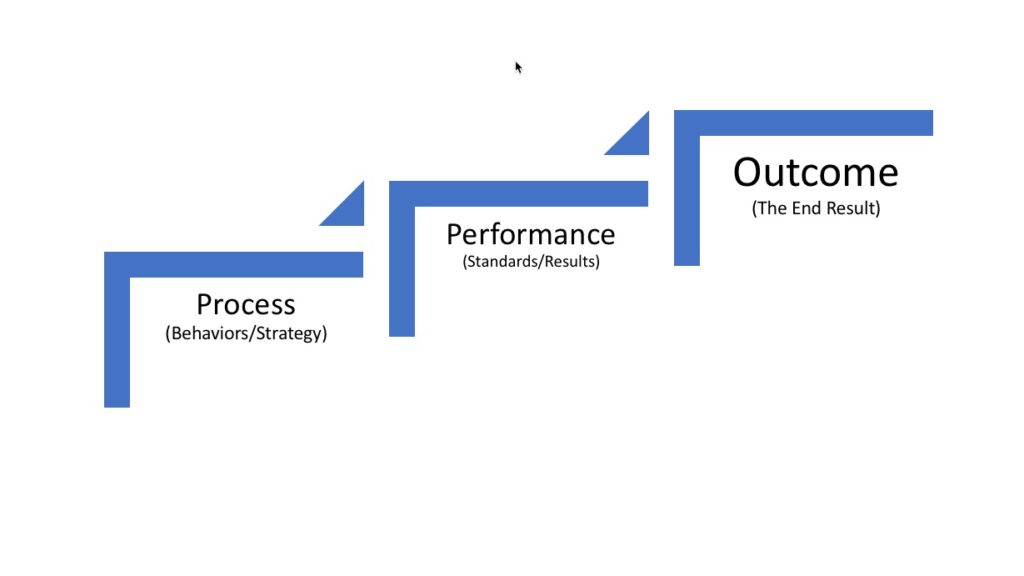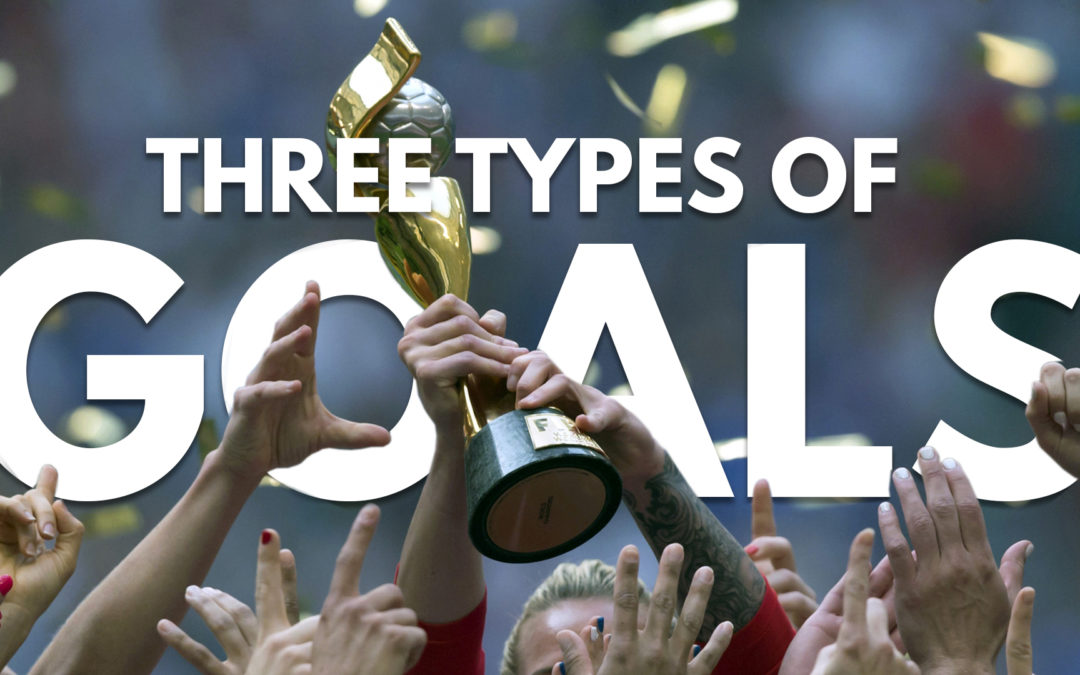Effective goals motivate and inspire us, increase success rate, focus us, and reduce frustration. An effective goal setting process helps us understand where we currently are, helps us choose where we want to go, and assess the best steps to take to reach our ultimate outcome goals.
Three types of Goals
There are 3 types of goals: Outcome goals, process goals, and performance goals. Each of the 3 types differs based on how much control we have over it. We have the most control over process goals and the least control over outcome goals.
Outcome goals (Results). Outcomes goals are specific and spell out the results you hope to achieve in the end. For example, I will lose 30 lbs. While they give you a target, they don’t tell you how to reach it. In business and competitive sports, outcome goals may be goals like winning a championship or winning a certain % of the market or hitting a certain sales target. In these cases, outcome goals compare your performances with those of other competitors. Here is another example. A high school student may set an outcome goal to become a doctor. That goal means that she would have to take exams and compete with other students over few spots into medical school. While you can study hard, you don’t grade your exams. While you can prepare well for your interviews, you don’t choose yourself. As such, with most outcome goals, you can take steps that influence the outcome in your favor but the results are ultimately not under your control.
Process goals (Behaviors). Process goals (also called procedural goals) are the behaviors or the strategies that will help us to perform well and increase our chances of achieving our desired outcome goals. It’s the goal that sets the path to an outcome goal. E.g. The process goal for losing weight may include reducing calories, riding your bicycle, and drinking lots of water. Process goals are particularly helpful for weight loss because they help you focus on changing behaviors and habits that are necessary for losing weight. A nice thing about process goals is that they are within our control.
Sample behavior (process) goals:
- I will excise 30 minutes a day, five days a week, for a period of one month.
- I will drink 2-3 liters of water every day for one month.
- I will eat only two meals per day for one month.
- I will take 20-20 minutes to eat each of my meals for a period of one week.
Notice that all goals, whether they are outcome, process, or performance goals, need to be SMART: Specific, Measurable, Attainable, Relevant, and Time-bound.
Performance goals (Standards). Performance goals set the standards at which we will perform our process goals. This is focused on results. For example, in a business, process goals may be akin to core values which spell out how you will behave to achieve your goals. Performance goals are actually the results you produce that affect the bottom line. E.g. not simply making sales calls but actually converting customers to buyers. Meeting your performance goals on your process goals is the surest way to achieve your outcome goals. E.g. the performance goals for losing weight based on the process goals above may be to lose weight by eating 1200 calories a day or less, riding my bike for 30 minutes 5 times per week, and drinking 3 liters of water at per day for a period of one month.

Divide goals into short-term, mid-term, and long-term
Goals can be categorized according to time into short-term, mid-term, and long-term goals. Long-term goals help motivate and focus us on the big picture. However, they can seem too big and too far removed. I encourage people to break down their long-term goal into smaller short-term and mid-term goals and to celebrate when they meet those small milestones on the way to the final outcome goal. E.g. a goal to lose 60 lbs in one year can be broken down to 5 lbs per month and 30 lbs in 6 months.
Combine Outcome, Process, and Performance Goals for Maximum Success
Research has shown that combining outcome, process, and performance goals increase the success rate. For effective weight loss, I encourage my patients to incorporate all three into their weight loss goal statement. When I coach leaders, I encourage them as well to have the same three elements incorporated into their goal statements. However, I advise them that when they have set their outcome goals, they should stop focusing on the outcome goal (or end goal) and really focus daily on their process and performance goals which are the behaviors and standards that will get them to their end goal. For example, you’ve decided that you want to lose 50 lbs in one year. Great! Then stop focusing so much on that but 50 lb goal but start focusing daily and tracking on the behaviors and standards that will help you lose that weight.
When setting goals, you should to visualize and choose the desired outcome. After that, you should focus on the process and your performance. Anybody can choose an outcome goal, and that doesn’t mean they will achieve it. But it takes courage, discipline, and leadership to do your process and performance goals which will lead you to victory.
This is true for athletes as well. You are not in control of who wins the tournament. What you have in your control are your process goals (behaviors) and your performance goals. If you focus on what is in your control, what is outside your control often works out well.
Because effective weight loss happens slowly, I encourage people to rejoice when they are succeeding at their process and performance goals because in due time they will reap the benefits of achieving their outcome goals if they do not become discouraged and quit. This is true with most goals as well.
Don’t become weary in doing good, for at the proper time we will reap a harvest if we do not give up.

